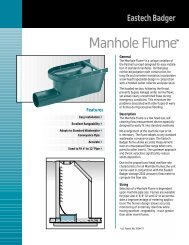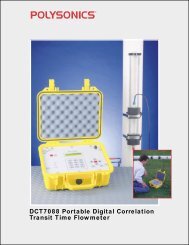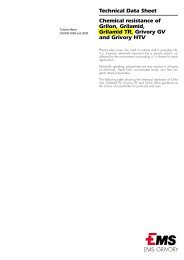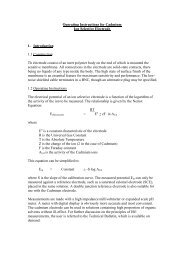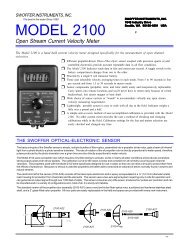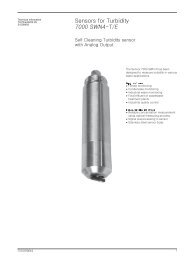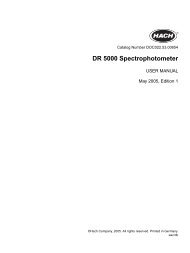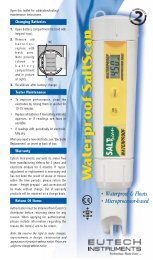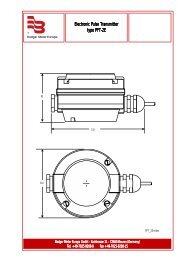FIND OUT MORE - Labex
FIND OUT MORE - Labex
FIND OUT MORE - Labex
You also want an ePaper? Increase the reach of your titles
YUMPU automatically turns print PDFs into web optimized ePapers that Google loves.
2<br />
Specifications*<br />
Operating Mode<br />
Transmittance (%), Absorbance and<br />
Concentration<br />
Source Lamp<br />
Tungsten (visible) and Deuterium (UV)<br />
Pre-Installed Programs<br />
More than 240<br />
Available User Programs<br />
50<br />
Data Storage<br />
1000 points<br />
Scan Data Storage<br />
20 Scans<br />
Export Capability<br />
.csv (comma-separated values)<br />
file format<br />
Wavelength Range<br />
190 to 1100 nm<br />
Wavelength Accuracy<br />
±1 nm in wavelength range 200-900 nm<br />
Wavelength Resolution<br />
0.1 nm<br />
Wavelength Calibration<br />
Automatic<br />
Wavelength Selection<br />
Automatic–based on selected program<br />
Manual–in all modes except stored<br />
programs<br />
Scanning Speed<br />
900 nm per minute in 1 nm steps<br />
Spectral Bandwidth<br />
2 nm<br />
Photometric Range<br />
±3.0 Abs in wavelength range<br />
200-900 nm<br />
Photometric Accuracy<br />
5 mAbs at 0.0 to 0.5 Abs<br />
1% at 0.5 to 2.0 Abs<br />
Photometric Linearity<br />
Deviation less than 0.5% up to 2 Abs<br />
Deviation less than or equal to<br />
1% at greater than 2 Abs<br />
Stray Light<br />
KI-solution at 220 nm: greater than<br />
3.3 Abs / less than 0.05%<br />
Enclosure Rating<br />
IP 31<br />
Multiple Language Interface<br />
English, Spanish, French, German,<br />
Italian, Portuguese, Chinese, Japanese,<br />
Korean (please contact your Hach<br />
representative for availability of<br />
additional languages)<br />
Operating Temperature<br />
10 to 40°C (50 to 104°F)<br />
Operating Humidity<br />
80% relative humidity (non-condensing)<br />
maximum<br />
Storage Requirements<br />
-25 to 60°C (-13 to 140°F)<br />
80% relative humidity (non-condensing)<br />
maximum<br />
Power Requirements<br />
100 to 120 V or 200 to 240 V; 50/60 Hz;<br />
automatic changeover<br />
Interface<br />
USB 1.1<br />
Connections<br />
1 x USB type B (PC)<br />
2 x USB type A (USB storage device,<br />
printer, keyboard, barcode scanner)<br />
Sample Cell Compatibility<br />
1 x 1 cm, 2 x 1 cm, 5 x 1 cm,<br />
10 x 1 cm (with optional adapter)<br />
13 and 16 mm round<br />
1-in. round<br />
1-in. square<br />
AccuVac ®<br />
Pour-Thru with 1-in. and<br />
1 cm path lengths<br />
Accessories<br />
Sipper Module with 1 cm cell<br />
Carousel Holder (sample changer)<br />
(Seven 1 x 1 cm cells)<br />
Pour-Thru Cell Module, 1-in. or 1 cm<br />
Brewery Analysis Software<br />
DataTrans Software<br />
Printer: USB (PCL3 Language)<br />
External keyboard: USB<br />
External barcode reader: USB<br />
Dimensions<br />
450 x 200 x 500 mm<br />
(17.7 x 7.9 x19.7 in.) width, height, depth<br />
Weight<br />
15.5 kg (34.2 Ib.)<br />
*Specifications subject to change without notice.<br />
Engineering Specifications<br />
1. The spectrophotometer instrument shall be a multiwavelength,<br />
UV-Visible, reference beam spectrophotometer<br />
designed for laboratory analysis of multiple analytes.<br />
2. The instrument shall be capable of measuring the following<br />
substances or characteristics: alachlor; aluminum; arsenic;<br />
atrazine; barium; benzotriazole; boron; bromine; cadmium;<br />
chloramine (mono); chloride; chlorine dioxide; chlorine;<br />
chromium; cobalt; color; copper; cyanide; fluoride;<br />
formaldehyde; hardness; hydrazine; iodine; iron; lead;<br />
manganese; mercury; molybdenum; nickel; nitrogen (as<br />
ammonia, nitrate, nitrite, total nitrogen, total Kjeldahl<br />
nitrogen); dissolved oxygen; chemical oxygen demand;<br />
oxygen scavengers; ozone; pcb (polychlorinated biphenyls);<br />
phenols; phosphonates; phosphorus; potassium; quaternary<br />
ammonium compounds; selenium; silica; silver; sulfate;<br />
sulfide; surfactants; suspended solids; tannin and lignin;<br />
total organic carbon; tolyltriazole; total petroleum<br />
hydrocarbons (TPH); trihalomethanes (THM); toxicity;<br />
volatile acids; and zinc.<br />
3. The following tests shall conform to USEPA-compliant<br />
methods: arsenic; chlorine dioxide; chlorine, free; chlorine,<br />
total; chromium, hexavalent; copper; fluoride; iron (total);<br />
manganese; nickel; nitrogen (ammonia); nitrogen (nitrite);<br />
chemical oxygen demand; phenols; phosphorus (reactive);<br />
phosphorus (total); sulfate; sulfide; and zinc.<br />
4. The wavelength range of the instrument shall be from 190 to<br />
1100 nm with accuracy of ±1 nm and resolution of 0.1 nm.<br />
5. The instrument, depending on the test selection, shall<br />
automatically select the wavelength.<br />
6. Readout modes shall include transmittance (%), absorbance,<br />
concentration, optional wavelength scan and time course<br />
graphs.<br />
7. The interface of the instrument shall be graphical with<br />
touch screen.<br />
8. The instrument shall provide graphical display and be capable<br />
of printing test results.





